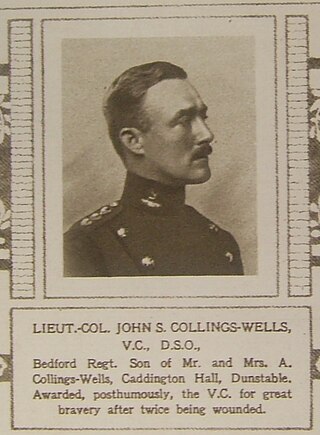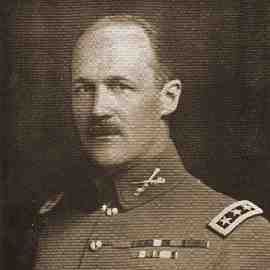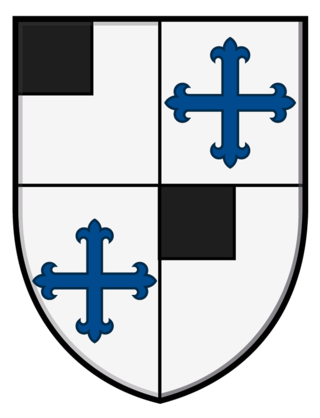Related Research Articles

Lieutenant-Colonel John Stanhope Collings-Wells VC DSO was an English recipient of the Victoria Cross, the highest and most prestigious award for gallantry in the face of the enemy that can be awarded to British and Commonwealth forces. He was educated at Uppingham School and Christ Church, Oxford, where he joined the Apollo University Lodge.

Ivor Thord-Gray was a Swedish-born adventurer, sailor, prison guard, soldier, government official, police officer, rubber plantation owner, ethnologist, linguist, investor, and author. He participated in thirteen wars spanning the continents of Africa, Asia, North America, and Europe.

General Sir William Platt was a senior officer of the British Army during both the First and the Second World Wars.
Major-General Sir Thomas Townsend Pears KCB was a senior British Indian Army officer who went on to be Military Secretary to the India Office.

Major-General Sir Reginald John Pinney was a British Army officer who served as a brigade and divisional commander on the Western Front during the First World War. While commanding a division at the Battle of Arras in 1917, he was immortalised as the "cheery old card" of Siegfried Sassoon's poem "The General".
Major General Sir William Douglas Smith was a British Army officer who became Lieutenant Governor of Jersey.
Brigadier-General Sir Charles Loftus Bates was a British Army officer who served in the Second Boer War and the First World War. He was a cavalry officer in the 1st (King's) Dragoon Guards and the commanding officer (CO) of the Northumberland Hussars, part of the Yeomanry reserve.
Major-General Philip de FonblanqueDSO was a senior British officer, who at the start of the Second World War, organised the logistics for the British Expeditionary Force in France and Belgium. Already a sick man, the result of his exertions was that he died shortly after his evacuation from France in June 1940.
Lieutenant-Colonel Arthur Kennedy Rawlins was a British Indian Army officer.

Brigadier-General Henry Clifford Rodes Green, was a senior British Army officer during the First World War.
Colonel Henry Huntly Leith Malcolm was a Scottish officer in the British Army during the Anglo-Egyptian War and World War I.

Major–General Hugh Clement Sutton was a General in the British Army, Deputy Assistant Director of Railways in South Africa between 1900 and 1902 and Lieutenant-Governor and Secretary of Royal Chelsea Hospital between 1923 and 1928.
Brigadier Reginald Howlett was a British Army officer who became colonel of the Royal Fusiliers.

Major General William Norman Herbert was a senior British Army officer who served as colonel of the Northumberland Fusiliers and commanded the 23rd (Northumbrian) Division in the Battle of France during the Second World War.
Major-General Sir Charles Patrick Amyatt Hull, was a senior British Army officer who served during the Second Boer War and World War I. He was the father of Field Marshal Sir Richard Hull and the grandfather of Lieutenant General Richard Swinburn.
Colonel Sir George Murray Home Stirling, 9th Baronet CBE DSO was a Scottish British Army officer who was Lord Lieutenant of Stirlingshire from 1936 until 1949.
Major General William Robb was a senior British Army officer, who served in both World War I and World War II.

The 2nd Northumberland Rifle Volunteer Corps, also referred to as the Tynemouth Rifles, was an infantry unit of Britain's part-time Volunteer Force, raised as part of the [Rifle Volunteer Movement in the 1860s. It became the 5th Battalion, Northumberland Fusiliers in the Territorial Force, serving during the First World War, and then the Territorial Army. It converted to an anti-aircraft role just prior to Second World War, and continued to serve until it was amalgamated in 1950.

Lieutenant-Colonel Rowland Edward Power was in Command of the 1st Battalion of the South Nigeria Regiment between 1905 and 1906, the 2nd Battalion of the Buffs during World War I, the 1st Battalion of the Buffs at the end of World War I, and from 1923 until his retirement in 1927, the 1st Battalion of the Buffs in Gibraltar.
Lieutenant General Daulet Singh, PVSM was a general officer in the Indian Army. He was the General Officer Commanding-in-Chief Western Command when he was killed in the 1963 Poonch Indian Air Force helicopter crash.
References
- 1 2 "The Late Lt.-Col. M. L. Pears". North Eastern Railway Magazine. November 1916. p. 257.
- ↑ "Page 1149 | Issue 26602, 26 February 1895 | London Gazette | The Gazette". www.thegazette.co.uk. Retrieved 2023-12-24.
- ↑ "Page 4139 | Issue 27095, 4 July 1899 | London Gazette | The Gazette". www.thegazette.co.uk. Retrieved 2023-12-24.
- ↑ "No. 27521". The London Gazette . 3 February 1903. p. 680.
- ↑ "Page 5153 | Issue 27588, 14 August 1903 | London Gazette | The Gazette". www.thegazette.co.uk. Retrieved 2023-12-24.
- ↑ "Page 7822 | Issue 27856, 21 November 1905 | London Gazette | The Gazette". www.thegazette.co.uk. Retrieved 2023-12-24.
- ↑ "Page 10795 | Supplement 29009, 15 December 1914 | London Gazette | The Gazette". www.thegazette.co.uk. Retrieved 2023-12-24.
- ↑ "32nd Division". The Long, Long Trail. Retrieved 2023-12-24.
- 1 2 3 Shakespear, Lt-Col. A Record of the 17th and 32nd Battalions Northumberland Fusiliers 1914 - 1919 (N.E.R.) Pioneers. Uckfield: The Naval & Military Press Ltd. ISBN 9781843426875.
- ↑ "Page 986 | Issue 12947, 5 June 1916 | Edinburgh Gazette | The Gazette". www.thegazette.co.uk. Retrieved 2023-12-24.
- ↑ CWGC. "Lieutenant Colonel Maurice Loraine Pears | War Casualty Details 659421". CWGC. Retrieved 2023-12-24.